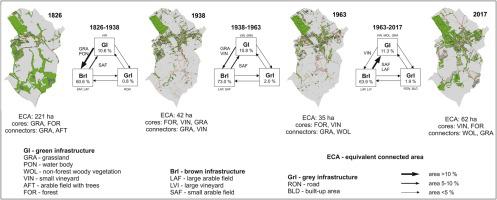当前位置:
X-MOL 学术
›
Agric. Ecosyst. Environ.
›
论文详情
Our official English website, www.x-mol.net, welcomes your feedback! (Note: you will need to create a separate account there.)
The role of traditional agricultural landscape structures in changes to green infrastructure connectivity
Agriculture, Ecosystems & Environment ( IF 6.6 ) Pub Date : 2020-10-01 , DOI: 10.1016/j.agee.2020.107071 Hana Skokanová , Patrik Netopil , Marek Havlíček , Bořivoj Šarapatka
Agriculture, Ecosystems & Environment ( IF 6.6 ) Pub Date : 2020-10-01 , DOI: 10.1016/j.agee.2020.107071 Hana Skokanová , Patrik Netopil , Marek Havlíček , Bořivoj Šarapatka

|
Abstract A reduction and disappearance of traditional agricultural landscape structures (TALSs) has been taking place throughout Europe. TALSs are a mixture of small arable fields with trees, vineyards with and without trees, orchards and field margins, and represent an important component of green infrastructure (GI). This is true especially in intensively used landscapes where GI elements in a true sense (natural or semi-natural elements) are quite rare. Changes of GI and its connectivity in four periods between 1826 and 2017 were studied in the agricultural landscape of South Moravian region, the Czech Republic. Changes of GI were expressed as transitions to different land use categories, with changes of GI connectivity expressed by morphological spatial pattern analysis (MSPA) and equivalent connected area (ECA). Our results showed that the GI was the best connected in the mid-19th century through large core areas of grasslands, forests and water bodies. GI was significantly reduced and its connectivity lowered already in the first half of the 20th century during the first wave of agricultural intensification. During this time, grassland was turned to arable fields and water bodies and wetlands were dried out. The reduction of GI continued during the socialist period (1948–1990), leading to further decreases in connectivity and an overall homogenization of the landscape. During this period and continuing until the present, TALSs and especially small vineyards, started to play a significant role in GI connectivity. Nowadays, GI connectivity has started to again increase also through the introduction of new types of GI. These are bio-centres and bio-corridors (patches of woods that are newly planted in order to create an ecological network) and elements connected with agri-environmental schemes (e.g. erosion control grassed belts).
更新日期:2020-10-01



























 京公网安备 11010802027423号
京公网安备 11010802027423号